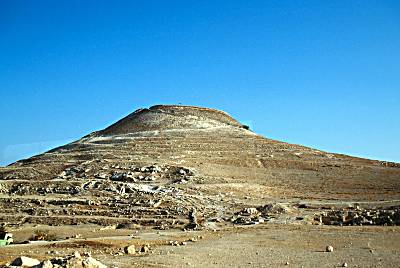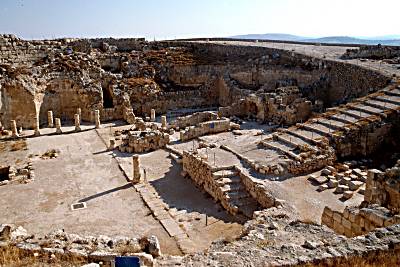|
|
|
|
|
Herodium It
is a famous fortress King Herod built for himself around the year 20 B.C. Herod
chose the site after an important military victory against the Hasmoneans of
Jerusalem, which helped to launch his career in 40 B.C. As an Idumean, Herod was
a descendant of Arab tribesmen, who originally lived both east of the Jordan
River and in the southern part of Palestine, and thus was despised by the elite
of Jerusalem. Because Herod liked this area very much, the palace was used for
leisure during his lifetime; it also served as the family burial place and later,
as his memorial. Herod
invested a great deal of labor and resources in various building projects,
including the seaport of Caesarea, the city of Sebaste (Samaria) near Nablus,
and the Tomb of the Patriarchs in Hebron. Yet the Herodiurn is the enterprise he
wished to be remembered for. He chose a natural hill of which he raised the
level by vaults and then surrounded the structures on top with fill, so that the
hill - rising 100 meters above its surroundings - is an imposing sight from
Bethlehem five kilometers to the northwest. The
main structure consists of two parallel circular walls with a diameter of nearly
50 meters. Within this structure the eastern half was made up of a garden
surrounded by columns. The western half included a triclinium dining room, a
bathhouse, and dwelling quarters. 15 meters below floor level was a network of
four plastered cisterns. The
remains at the bottom of the hill cover an expanse of 38 acres. Lower Herodium
included a magnificent pool complex, a bathhouse, and other dwellings. The
character of this place has been preserved in the Arabic name Jebel Fureidis or
Paradise Mountain. Just
as Herod had designed this palace and burial place as a fortress, it was used in
a military function by Jewish rebels in both the first (66-73) and second
(132-135) revolts against Rome. These Zealots dug a network of security tunnels
beneath the fortress, 300 meters of which have been explored. After
four centuries in which the Herodium appears to have been abandoned, the site
began to be used as a religious center in the fifth century. On the top of the
Herodium, one chapel appears to have been occupied by a monastic community. In the lower part of the Herodium, three different contemporary churches have been excavated all having beautiful mosaic floors.
Herodium - Jebel Fureidis
Herodium - the Remains of the fortress |


